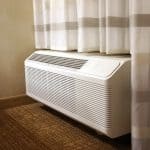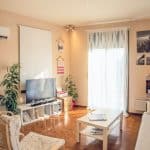A packaged terminal air conditioner, or PTAC, is a ductless, self-contained air conditioning unit that heats and cools contained areas. PTACs are used as a way to cut costs and increase energy efficiency in places like hotels, hospitals, senior residential facilities, apartments and residential add-ons like sunrooms. They are most commonly seen under the windows of many of the hotels and motels across the country.
While PTAC dimensions are standardized at 42×16 inches, 36×15 inches, and 40×15 inches, the units come in four different cooling capacities ranging from 7,000 BTUs to 17,000 BTUs.
A British Thermal Unit is a way to measure energy. The technical definition describes it as the amount of heat required to raise the temperature of one pound of water by one degree Fahrenheit. For air conditioners, the BTUs indicate how much energy it takes to remove heat from the air using the compressor system.
The number of BTUs tells you how powerful your unit is and describes how much energy can be produced per hour. If a PTAC unit is labeled as 5,000 BTUs, it can produce 5,000 BTUs of energy per hour.
If the BTU capacity of your PTAC is too small, your room won’t get adequately cooled. Inversely, if the BTU capacity is too large for your space, it will leave the room feeling damp and can lead to issues with mold. In addition, an oversized PTAC unit actually wastes energy.
The PTAC Inc. team recommends a 5,000 BTU PTAC for a room between 100-150 square feet. For each 50 square foot increment, add 1,000 BTUs.
- If the room is heavily shaded, reduce capacity by 10 percent. That means that if the square footage of your room is 150 square feet, you’ll need 4,500 BTUs as opposed to 5,000 BTUs
- If the room is very sunny, increase capacity by 10 percent
- If more than two people regularly occupy the room, add 600 BTUs for each additional person
- If the unit is used in a kitchen, increase needed capacity by 4,000 BTUs
- A second story room may need a 10 percent increase
Using a PTAC with a BTU level higher than what you need can cause the unit to cycle on and off too frequently. That can shorten the unit’s lifespan. If you get one that is too small, the unit will run almost continuously, but never get the room to your desired temperature.





